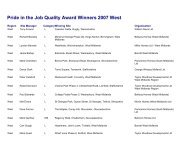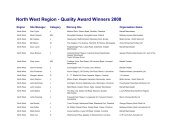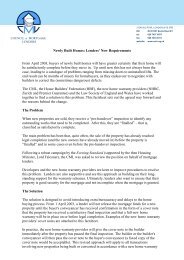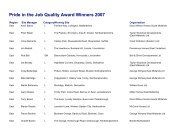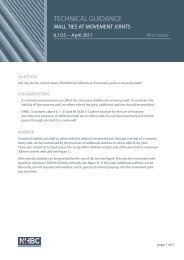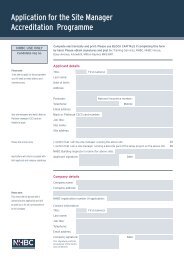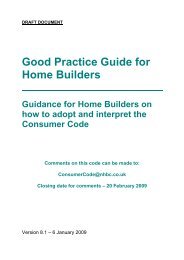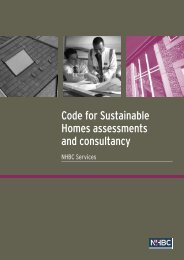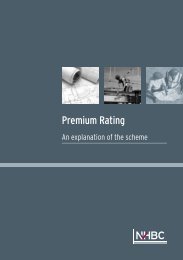June 2010 - NHBC Home
June 2010 - NHBC Home
June 2010 - NHBC Home
You also want an ePaper? Increase the reach of your titles
YUMPU automatically turns print PDFs into web optimized ePapers that Google loves.
Issue 47<br />
<strong>June</strong> <strong>2010</strong><br />
Regulations changes<br />
A new requirement to Part F means<br />
that where possible, fixed mechanical<br />
ventilation systems require testing and<br />
commissioning. In addition, for both<br />
intermittent and continuous mechanical<br />
ventilation installations, air flow should<br />
be measured. This would include cooker<br />
hoods for kitchens and extract fans to<br />
bathrooms.<br />
Details of this data must then be sent<br />
to the Building Control Body within<br />
five days of completion, adding another<br />
procedure to follow at the completion<br />
stage.<br />
It is also a requirement to hand over<br />
sufficient information to the building<br />
owner in relation to the systems<br />
installed in a new dwelling.<br />
Main changes<br />
As mentioned above the most<br />
significant change is to dwellings<br />
with air permeability of less than<br />
5.0m 3 /(h.m 2 ).<br />
By choosing a continuous mechanical<br />
extract system, Part F <strong>2010</strong> now<br />
removes the need for background<br />
ventilation in dwellings designed with<br />
air permeability rates above 5.0m 3 /<br />
(h.m 2 ). There are also benefits in SAP<br />
2009 for continuous systems, which<br />
may lead designers to adopt whole<br />
house mechanical extract ventilation<br />
systems, possibly including heat<br />
recovery as well, which would maximise<br />
the SAP benefits.<br />
If using passive stack ventilation,<br />
internal pipes should now be sized at<br />
125mm diameter serving all spaces,<br />
an increase from the Part F 2006<br />
requirements.<br />
Published alongside the new<br />
regulations is the Domestic Building<br />
Services Compliance Guide, in which a<br />
new requirement for specific fan power<br />
of less than 0.5 watt/sec applies for<br />
intermittent extract fans.<br />
ACTION<br />
Part J <strong>2010</strong> – Combustion<br />
appliances and fuel storage<br />
systems<br />
Introduction<br />
There are a number of changes in<br />
the new Part J <strong>2010</strong> beyond those<br />
relevant to the new requirements<br />
of Part L <strong>2010</strong>, the most significant<br />
change is the requirement for carbon<br />
monoxide alarms in dwellings with fixed<br />
combustion appliances.<br />
There is new guidance on protection to<br />
oil tanks, external vertical flues, access<br />
to concealed flues and additional<br />
ventilation requirements for open<br />
flued appliances in dwellings with air<br />
permeability of less than 5.0m 3 /(h.m 2 ).<br />
Main Changes<br />
There is now a requirement to provide<br />
a carbon monoxide alarm to dwellings<br />
with a fixed combustion appliance,<br />
although the Approved Document<br />
guidance applies only to solid fuel and<br />
biofuel appliances. An alarm should<br />
be sited between 1m and 3m of an<br />
appliance, and be provided with a<br />
suitable long term power supply.<br />
There is guidance on the provision of<br />
access to concealed flues/chimneys.<br />
Inspection hatches should be at least<br />
300mm x 300mm, the number and<br />
location must be sufficient to allow<br />
visual inspection of the flue/chimney<br />
system, and check that:<br />
• The flue/chimney is continuous<br />
throughout its length<br />
• Joints are correctly assembled<br />
and sealed<br />
• The flue/chimney is adequately<br />
supported throughout its length, and<br />
• Any required gradient or drain<br />
points for condensate are provided.<br />
Flues should be designed not to pass<br />
through other dwellings, and access<br />
If you would like to find out more about the changes or would like to<br />
talk about a new project please contact 0844 6331000 and ask for<br />
‘Building Control’ / ‘Colin Blatchford-Brown’, or visit our website<br />
www.nhbc.co.uk/bc<br />
should not adversely affect fire,<br />
thermal or acoustic provisions.<br />
To link in with the requirements in<br />
Part L <strong>2010</strong>, for dwellings with air<br />
permeability of less than 5.0m 3 /<br />
(h.m 2 ), there are additional ventilation<br />
requirements for open flued appliances.<br />
For example an appliance with a<br />
rated output up to 50kW should have<br />
850mm 2 /kW of permanent ventilation<br />
for this level of air permeability as<br />
opposed to 550mm 2 /kW for more<br />
leaky dwellings.<br />
Another consideration within Part<br />
J <strong>2010</strong>, is the potential requirement<br />
to provide additional containment<br />
protection to oil tanks up to 3500<br />
litres for new dwelling. If a new<br />
dwelling is located within Zone 1 of<br />
the Environment Agency Groundwater<br />
Source Protection Zone (SPZ), then<br />
secondary containment is required to<br />
the oil tank. Further information on the<br />
mapping can be found at<br />
www.environment-agency.gov.uk/<br />
research/library/maps.<br />
And finally there is now clarification on<br />
the recommended flue outlet position<br />
for external vertical flues fixed to an<br />
outside wall, essentially to comply as if<br />
it were a normal chimney or flue above<br />
a pitched roof.<br />
…and building regulation changes<br />
in Scotland<br />
In April the Scottish Government<br />
published the <strong>2010</strong> edition of<br />
the Technical Handbooks. The<br />
amendments to the Scottish<br />
building regulations come into<br />
force on 1 October <strong>2010</strong>. The<br />
handbooks can be downloaded<br />
from the Scottish Government<br />
website (http://www.scotland.gov.<br />
uk/Topics/Built-Environment/<br />
Building/Building-standards/<br />
publications/pubtech).<br />
Alternatively hard copies can be<br />
purchased from The Stationery<br />
Office (TSO).<br />
7



